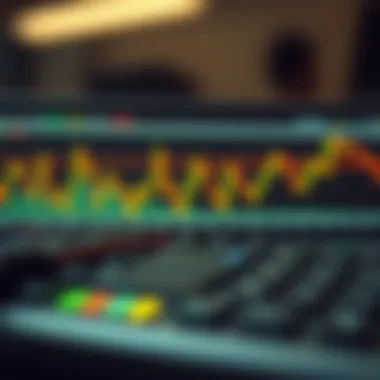Understanding the Stochastic Oscillator in Trading


Intro
In today's fast-paced financial markets, the ability to analyze trends and make informed trading decisions is paramount. One tool that has made its mark in this realm is the stochastic oscillator. While it might sound like a complex concept, breaking it down reveals its fundamental role in evaluating market conditions. This article aims to guide you through the ins and outs of the stochastic oscillator, equipping both seasoned traders and newcomers with valuable insights.
The key to successful trading lies in understanding market dynamics. Investors continuously seek out indicators that help delineate overbought and oversold conditions. The stochastic oscillator, as a momentum indicator, provides a reliable means to gauge market sentiment and make pivotal trading decisions. Through careful exploration of its components, derivation, applications, and limitations, we will unravel the layers of this crucial tool.
By the end of our discussion, readers will walk away with not just the theoretical knowledge of the stochastic oscillator but also a practical understanding of how it can be implemented in diverse trading strategies. So, let’s embark on this journey to decode the relevance and intricacies of the stochastic oscillator in financial analysis.
Investment Products Overview
Definition of Investment Products
Investment products are financial instruments that individuals and institutions use to allocate their capital in the hopes of generating returns. These products come in various forms and cater to different risk appetites and investment horizons. At the crux of investing lies the understanding of these products, as each carries its inherent risk and reward potential.
Types of Investment Products
Investment options are plentiful and widespread. Here is a closer look at several common types:
- Equities: Stocks represent ownership in a company, offering dividends and the possibility of capital appreciation.
- Bonds: Bonds are loans to governments or corporations that pay periodic interest and return the principal upon maturity.
- Mutual Funds: These are pooled investment vehicles managed by professionals, allowing investors to buy a diversified portfolio.
- Exchange-Traded Funds (ETFs): Similar to mutual funds but traded on stock exchanges, providing liquidity.
- Derivatives: Instruments like options and futures are contracts that derive value from underlying assets.
Understanding these products will lay a solid foundation for analyzing indicators like the stochastic oscillator. The ability to discern how these investment avenues behave in various market conditions will amplify the utility of such analytical tools.
Remember: Investment products come with risks. Hence, thorough due diligence is essential before diving into any financial commitment.
In the subsequent sections, we will unravel the core components of the stochastic oscillator and elaborate on its practical applications—providing you with a comprehensive guide to navigating this timely and valuable indicator.
Preface to Stochastic Oscillator
The Stochastic Oscillator is a key player in the realm of technical analysis, and understanding its nuances can provide valuable insights to traders and investors alike. This momentum indicator is crucial for identifying overbought and oversold conditions in financial assets, making it a staple in many trading strategies. During unsteady market conditions, being aware of these states can mean the difference between a sound decision and a costly misstep. By integrating the Stochastic Oscillator into their analytical framework, traders can enhance their market predictions and refine their approach to investment.
Definition and Overview
At its core, the Stochastic Oscillator compares a security's closing price to its high-low range over a specific period of time. The idea is simple yet powerful: it reflects the momentum of price movements and helps traders gauge the potential for a reversal. A quick glance at its reading reveals essential data — is the market heating up to the boiling point or cooling down? The formula is often summarized as follows:
- %K Line: This is the main line that expresses the current price relative to the price range.
- %D Line: This is essentially a moving average of the %K line, smoothing out the volatility for clearer insights.
Often, traders look for signals either to buy low when the oscillator indicates oversold conditions or to sell high when it's overbought. However, it's important to remember that, like all indicators, the Stochastic Oscillator should not be used in isolation but rather in conjunction with other analytical tools.
Historical Context and Development
The Stochastic Oscillator was developed in the late 1950s by George C. Lane, whose work fundamentally affected the trajectory of technical analysis. Lane’s genius lay in recognizing that price movements do not occur in a vacuum; rather, they are influenced by various psychological factors in the market. Initially developed for use in stocks, the Stochastic Oscillator has since broadened its application to commodities, forex, and other asset classes. The original formulation revolved around understanding price momentum, and as markets evolved, so did its usage.
Through the years, the oscillator has been adopted and adapted by countless traders, with many now integrating complementary strategies to enhance its effectiveness. The development of computer software has only increased its accessibility, allowing more traders to harness its power. However, despite its widespread application, one must tread carefully; understanding both the nuance and the limitations of the Stochastic Oscillator is vital for any serious trader.
"The Stochastic Oscillator is not just a tool; it is the lens through which many traders view the shifting tides of the market." – George C. Lane


By grasping its roots and evolution, traders can better understand why the Stochastic Oscillator remains so relevant today in orchestrating investment strategies.
Mathematical Foundations
The mathematical underpinnings of the stochastic oscillator are essential in grasping how this momentum indicator operates within financial markets. Understanding these foundations not only equips traders with the necessary tools to apply the oscillator effectively but also aids in interpreting its readings for better decision-making. At its core, the stochastic oscillator is built on a simple, yet powerful formula that focuses on price movement relative to historical extremes. This element enhances its value as a technical tool.
Components of the Stochastic Oscillator
The stochastic oscillator consists of three primary components: the current closing price, the lowest low over a period, and the highest high over a period. Each plays a significant role in determining the oscillator's output and consequently influences trading decisions.
Current Closing Price
The current closing price forms the foundation of the stochastic oscillator. This component represents the latest price at which a security has settled. It stands out as a key aspect because it gives traders an immediate reference point in terms of current market sentiment.
The pivotal nature of this value lies in its responsiveness. By being the most recent price, it reflects the latest market conditions, making it a popular choice in financial analysis. However, one unique feature is its susceptibility to sudden market moves that can skew perception. Traders must be wary of how much weight they place on this figure, particularly in volatile markets where prices may shift dramatically in short timeframes.
Lowest Low over a Period
Next, we have the lowest low over a specified period, which serves as a benchmark to assess whether the latest price is soaring above or falling far below the recent lows. This component is crucial because it provides context to the current closing price.
An essential characteristic of the lowest low is how it aids traders in identifying support levels. A dramatic departure from this low can indicate either a potential strong upward movement or a market correction. Yet, one must recognize that the values of the lowest low can vary significantly depending on the selected timeframe. Thus, traders need to exercise caution when interpreting its significance in a longer-term versus a shorter-term context.
Highest High over a Period
The highest high over a given period serves as a counterpart to the lowest low. It indicates where the recent peak lies relative to the current trading environment, making it another cornerstone of the oscillator's analytics.
Its key characteristic is its role in establishing resistance levels. When the current price approaches or exceeds the highest high, it may signal strong momentum, attracting traders to possibly initiate trades. However, a limitation is that high readings might not always equate to sustained upward trends, particularly in contexts where the market is underbaked.
Calculating the Stochastic Oscillator
Calculating the stochastic oscillator involves a defined formula based on the components discussed. Generally, it's expressed as:
where (C) is the current closing price, and "Lowest Low" and "Highest High" cover a specified time frame, typically 14 periods. Knowing how to apply this formula enables traders to derive actionable insights.
Understanding %K and % Lines
The oscillator's output is represented through two primary lines: the %K line and the %D line. The %K line is the faster line, while the %D line is a moving average of the %K, providing a smoothed perspective. Their interaction offers valuable information on market conditions.
Understanding these lines enriches a trader's grasp of the market layout, allowing for assessments of potential reversals and continuations in trends.
Interpretation of Stochastic Values
Interpreting stochastic values is a critical aspect in leveraging the stochastic oscillator effectively. This interpretation not only aids in recognizing market conditions but also in understanding potential reversal points, giving traders a more robust view of the market dynamics. It involves deciphering the oscillator's readings to derive both buy and sell signals, informing trading strategies.
The significance of interpreting stochastic values lies in their ability to provide insight into market momentum. The fluctuations in the %K and %D lines can highlight whether a particular asset is reaching a price point where buyers or sellers may lose interest. When these values are accurately understood, they can act as powerful indicators signaling when to enter or exit a position. This process inherently associates risk with reward, wherein the aim is to capitalize on market fluctuations before they turn against a trader’s position.
Overbought and Oversold Conditions


In the realm of trading, identifying overbought and oversold conditions is crucial. An asset is deemed overbought when the stochastic oscillator reads above 80, suggesting that the price may be poised for a pullback or correction, as buying interest becomes unsustainable. Conversely, an oversold condition occurs when the oscillator dips below 20, indicating that the asset has been excessively sold off, often translating to potential bargain opportunities for investors.
Understanding these thresholds is key:
- Overbought Indicators: These signal potential downside risk. Traders would consider selling or tightening their stops to protect profits.
- Oversold Indicators: These may represent buying opportunities, indicating that the price has likely deviated from its true value, warranting a potential rebound.
However, relying solely on these signals can be misleading. It's important to acknowledge market context such as news developments or economic shifts that may either reinforce or negate these readings.
Divergence Analysis
Divergence analysis is another pivotal aspect of interpreting stochastic values. This concept refers to instances when price movement contradicts the stochastic oscillator's direction. For example, if the price reaches a new high but the %K line shows a lower high, this performance mismatch can signal a weakening trend. This divergence serves as an early warning for potential reversals, providing traders with a strategic vantage point.
To effectively use divergence in trading:
- Bullish Divergence: Occurs when prices fall to a new low while the oscillator forms a higher low. This could suggest that, despite lower prices, buying momentum is beginning to build.
- Bearish Divergence: Happens when the price climbs to a new high, but the oscillator shows a lower high. This is often interpreted as a sign that upward momentum is weakening, hinting at a possible trend reversal.
Recognizing these divergence patterns doesn't guarantee profits, but they enhance a trader's decision-making process by providing insightful context. Evaluating divergences alongside other technical indicators could further solidify a trading strategy, paving the way for more informed investment decisions.
By closely monitoring stochastic values and delving into their interpretation, traders can navigate the complexities of financial markets with greater confidence and precision.
Practical Applications in Trading
The stochastic oscillator is not just a theoretical concept; it holds significant weight in the practical world of trading. Utilizing this momentum indicator effectively can be a game-changer for traders, offering them insights into potential market movements. By understanding the stochastic oscillator's role, traders can make informed decisions that enhance their strategies and potentially increase their profitability. Below, we will delve into its incorporation into various trading strategies and how it can work in synergy with other indicators.
Incorporating the Stochastic Oscillator in Strategies
Swing Trading
Swing trading is like finding a needle in a haystack – it requires patience and the ability to identify and react to price swings within a trend. This style involves holding positions for several days or even weeks, aiming to capture short to medium-term movements in stock prices. A key characteristic of swing trading is its flexibility; traders do not need to be glued to their screens all day, making it a beneficial choice for those who may have other commitments.
The unique feature of integrating the stochastic oscillator into swing trading lies in its ability to identify overbought and oversold conditions. For instance, a trader might look for stocks where the stochastic oscillator's value exceeds 80 to signal potential overbought conditions and consider selling. Conversely, values under 20 indicate oversold conditions, which could suggest a buying opportunity. However, swing traders must remain cautious; relying solely on this indicator can be misleading during strong trends. Hence, it’s prudent to combine it with other analyses to validate decisions.
Day Trading
Day trading, on the other hand, is all about quick, nimble moves, where traders buy and sell stocks within a single trading day. This high-stakes environment requires understanding market dynamics and significant focus on price movements. Many day traders favor the stochastic oscillator because it can reveal sensitive shifts in momentum, allowing for timely trades.
A typical strategy might involve looking for crossovers of the %K and %D lines; if the %K line crosses above the %D line while the stochastic value is below 20, it could signal a buying opportunity. While the stochastic oscillator is effective for identifying short-term conditions, day traders should be mindful of its potential to generate false signals, especially in volatile markets. As such, employing further confirmation from price action or volume can bolster a day trader's chances of success.
Position Trading
Position trading is for those who view trading as more of a marathon than a sprint; it involves taking a long-term view on asset prices. Traders in this category typically hold positions for weeks, months, or even years. This approach allows participants to benefit from overarching trends rather than daily fluctuations. The stochastic oscillator finds its place here by serving as a means to determine entry and exit points, complementing longer-market analyses.
One unique aspect of a position trader's strategy could involve using the stochastic oscillator to time entries when the indicator suggests a distinct shift in momentum. If a trader sees a consistent uptrend marked with intermittent dips into oversold territory, they may consider entering a position. However, caution is warranted, as position trading can expose traders to longer-term market swings that may not always align with the stochastics, so ongoing analysis is essential.
Combining with Other Indicators


Integrating the stochastic oscillator with complementary indicators can enhance the robustness of trading strategies. Common companions include moving averages, RSI, and MACD, enabling traders to confirm trends more solidly and reduce the risk of false signals. By studying the harmonization of these indicators, traders can cultivate better insights into market movements, allowing them to navigate the oft-treacherous waters of financial dealings.
"The key to successful trading is not just in the strategies employed but in the ability to adapt and learn from the market's ever-changing nature."
In summary, effective application of the stochastic oscillator in trading strategies such as swing, day, and position trading adds considerable depth for traders. By being aware of the strengths and weaknesses of their chosen method, they can navigate their trading journey with more confidence.
Limitations and Critiques
It's crucial to understand that no trading indicator is perfect, and the stochastic oscillator is no exception. Acknowledging its limitations and critiques allows traders to use this tool more effectively. Insight into the oscillator's weaknesses can lead to better-informed choices, enhancing overall trading strategies and risk management. Not every market condition is suitable for the stochastic oscillator, and traders must be aware of these factors to avoid costly mistakes.
Market Conditions Impacting Effectiveness
The effectiveness of the stochastic oscillator diminishes in certain market conditions. When the market is trending strongly, the oscillator might signal oversold or overbought conditions inaccurately. For example, in a strong bullish trend, readings can remain in the overbought territory for extended periods without a decline in price. This phenomenon is often referred to as a "trend-following trap," where traders could misinterpret the signal as a precursor to a reversal, when in reality, the existing trend continues.
Similarly, during bearish trends, the oscillator can indicate oversold conditions persistently while the price keeps falling. Thus, using the stochastic oscillator without recognizing the broader context can lead to misguided trades.
"Markets can be unruly, and indicators may not always reflect the truth of the situation."
Common Pitfalls for Traders
There are a few common pitfalls that traders may fall into when using the stochastic oscillator:
- Ignoring Multiple Time Frames: Focusing solely on a single time frame can result in a skewed view of market conditions. Traders should consider the oscillator's readings across various time frames to gain a more comprehensive understanding.
- Overreliance on Signals: Believing the oscillator signals are foolproof can be detrimental. It is essential to treat these signals as guidelines rather than definitive answers. Blindly following the indicator without considering other factors or indicators can lead to significant losses.
- Neglecting Confirmatory Analysis: Relying on the stochastic oscillator alone can lead to poor decision-making. It's wise to integrate it with other technical analysis tools, such as moving averages or trend lines, enhancing the reliability of the signals received.
Alternative Indicators Frequently Used
For traders looking for alternatives or supplements to the stochastic oscillator, several noteworthy indicators come into play:
- Relative Strength Index (RSI): This momentum oscillator measures the speed and change of price movements, providing insights into overbought or oversold conditions.
- Moving Average Convergence Divergence (MACD): MACD is a trend-following momentum indicator that shows the relationship between two moving averages of a security's price, often used to identify potential buy and sell signals.
- Bollinger Bands: These bands adjust according to market volatility, helping traders identify potential reversals based on price movement relative to the bands.
By integrating various indicators, traders can form a more balanced view of the market and refine their strategies to improve success rates. Always remember that each tool has its strengths and weaknesses; combining multiple perspectives can facilitate better trading decisions.
End
The conclusion of this article serves as a crucial recap of the concepts surrounding the stochastic oscillator. Understanding this tool is imperative for investors who wish to navigate the murky waters of financial markets with a degree of confidence. It offers insights not only into market conditions but also into investor sentiment, which can be the deciding factor in making informed trading decisions.
Summarizing Key Insights
Throughout the article, we’ve deeply explored the mechanics and relevance of the stochastic oscillator. Key takeaways include:
- Identifying Market Conditions: The stochastic oscillator is capable of signaling overbought or oversold conditions in a financial asset. This is integral for traders looking to optimize their entry and exit points.
- Components and Calculation: Understanding how to calculate the stochastic oscillator involves clarity on the essential components like the current closing price relative to the highest high and lowest low over a specified period.
- Practical Applications: The oscillator is not merely theoretical; it finds practical applications across various trading strategies. Whether in swing trading, day trading, or long-term position trading, it can be a beneficial addition to a trader's toolkit.
- Limitations: Acknowledging its limitations is equally important. Market dynamics such as trends and volatile conditions can skew its effectiveness, making critical knowledge of its pitfalls a must for traders.
A solid grasp of these points can empower investors to more effectively use the stochastic oscillator in their trading strategies and enhance their overall market analysis能力.
Future Trends in Oscillator-Based Analysis
As financial markets evolve, so too does the analysis and interpretation of indicators like the stochastic oscillator. Several trends are emerging:
- Integration with Machine Learning: Traders are now exploring advanced algorithms to analyze stochastic signals, which could yield less biased decisions based on historical data.
- Enhanced Customization: With the advent of mobile trading platforms and custom analytical tools, traders are seeking greater ability to tailor their oscillators to fit unique trading styles or asset classes.
- Increased Educational Resources: As more traders enter the market, there is a growing demand for resources that explain not only the mechanics of oscillators but also their application in real-world scenarios. Expect more workshops, webinars, and content that cater to this need.
- Broader Accessibility: Online communities, including forums on Reddit and various educational platforms, are making complex analytics more accessible, allowing even novice traders to learn about oscillators and their applications.
The future of oscillator-based analysis is not just about utilizing an indicator but truly understanding its place in the larger picture of market analysis. By keeping up with trends and leveraging new technologies, traders can enhance their decision-making processes.



